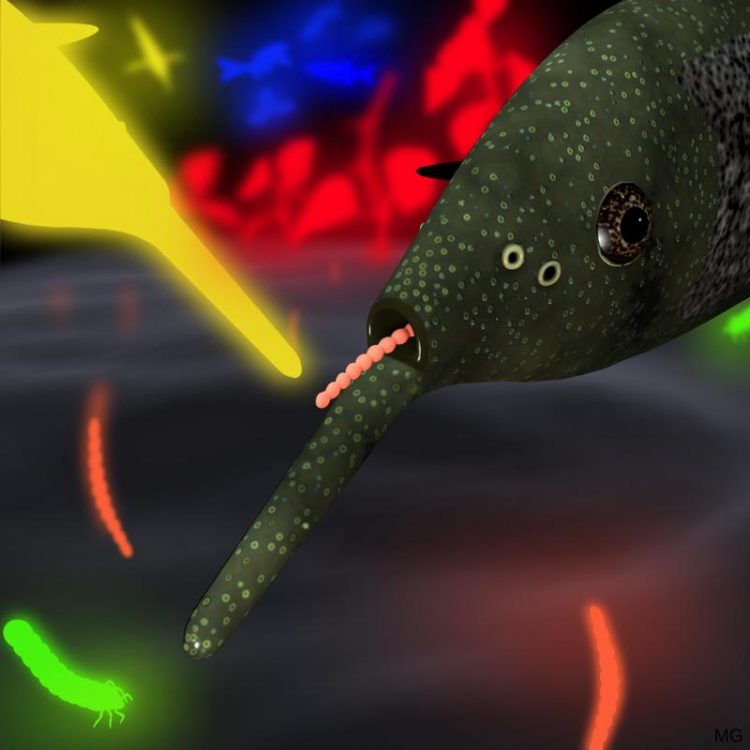Fish recognize their prey by electric colors

Artistic illustration: The elephantnose fish produces brief electric pulses, which it uses to perceive its environment. Different objects have different “electrical colors”. © Martin Gottwald/Uni Bonn
Elephantnose fish are nocturnal, which means they cannot rely on their eyes when hunting for prey. But they don’t need to:
They carry a kind of “electric flashlight” in their tail, which they use to generate short electrical pulses up to 80 times per second. Their skin, especially their trunk-like chin, is covered with electroreceptors: small sensors with which they can measure how these pulses are reflected by the environment.
And in this they have become champions: With their electro-sense they can estimate distances, distinguish forms and materials, differentiate between dead and living objects.
And more than that: Within fractions of a second, they can recognize whether mosquito larvae, their favorite food, are hiding in the gravel or sand at the bottom of their habitat. They can do this with considerable accuracy, largely ignoring the larvae of other insects.
How they do this was uncertain for a long time. Objects certainly change the intensity of the electrical signal in a characteristic way – some reduce it significantly, others reflect it better. “However, this is not enough to clearly identify prey animals,” explains Martin Gottwald of the Institute of Zoology at the University of Bonn.
“For example, the signal strength also decreases as the distance increases.” But there is another characteristic of living organisms: They also modify the shape of the electric pulses. But even this signal change depends on distance, size and position.
The combination of the two signal characteristics could solve these problems. The human eye works in a similar fashion: Its retina contains receptors for red, green and blue light. Our brain then uses the “mixing ratio” to calculate the color of the object we see. And this remains largely constant, no matter how large or far away the object in question is.
Two different receptor types
However, until now there was no proof that a similar process occurs in elephantnose fish. Nevertheless, it is clear that the animals have two different types of electric receptors. One only measures the intensity of the signal, the other additionally measures its shape.
“We have now been able to demonstrate that the fish uses the relation between these two measurements to identify their prey,” explains Prof. Dr. Gerhard von der Emde, who led the study.
At first, the scientists determined how intensity and shape of the localization signal behave in relation to each other depending on the type of object. “We found that this ratio is always constant for the same objects,” says von der Emde. “And this applies regardless of their distance or other environmental parameters.” “A mosquito larva therefore actually has a constant 'electrical color', which is clearly different from that of other larvae, plant parts, members of the same species or other fish,” adds Gottwald.
The researchers now examined the extent to which their laboratory animals used this information. They presented them with various electronic “mini chips” with a diameter of only one millimeter. Some chips produced different electrical colors; for example, they glowed like a mosquito larva or like other insect larvae. Other chips were electrically ‘colorless’, similar to a pebble.
Hungry for chips
The effect was astonishing: If the chips were colored like their favorite food, the elephantnose fish chomped down reflexively. They let themselves be fooled in this way in 70 percent of all cases, even though the fake meals did not smell at all like typical prey.
Even after numerous experiments, the animals did not learn to avoid the chips. They largely spurned differently colored chips, and even completely ignored electrically colorless ones. “This may suggest that the prey color is hardwired in the brains of the fish,” speculates von der Emde.
That would make sense: The electrical properties of living beings (and thus also their color) are decisively determined by their inner structure. And this cannot be changed easily. It is therefore barely feasible for a mosquito larva to simply add camouflage.
Prof. Dr. Gerhard von der Emde
Institute of Zoology
University of Bonn
Tel. +49 (0)228/73-5555
E-mail: vonderemde@uni-bonn.de
Martin Gottwald, Neha Singh, Andre Haubrich, Sophia Regett and Gerhard von der Emde: Electric Color Sensing in Weakly Electric Fish suggests Color Perception as a Sensory Concept beyond Vision; Current Biology; DOI: https://doi.org/10.1016/j.cub.2018.09.036
Media Contact
All latest news from the category: Life Sciences and Chemistry
Articles and reports from the Life Sciences and chemistry area deal with applied and basic research into modern biology, chemistry and human medicine.
Valuable information can be found on a range of life sciences fields including bacteriology, biochemistry, bionics, bioinformatics, biophysics, biotechnology, genetics, geobotany, human biology, marine biology, microbiology, molecular biology, cellular biology, zoology, bioinorganic chemistry, microchemistry and environmental chemistry.
Newest articles

Superradiant atoms could push the boundaries of how precisely time can be measured
Superradiant atoms can help us measure time more precisely than ever. In a new study, researchers from the University of Copenhagen present a new method for measuring the time interval,…

Ion thermoelectric conversion devices for near room temperature
The electrode sheet of the thermoelectric device consists of ionic hydrogel, which is sandwiched between the electrodes to form, and the Prussian blue on the electrode undergoes a redox reaction…

Zap Energy achieves 37-million-degree temperatures in a compact device
New publication reports record electron temperatures for a small-scale, sheared-flow-stabilized Z-pinch fusion device. In the nine decades since humans first produced fusion reactions, only a few fusion technologies have demonstrated…





















